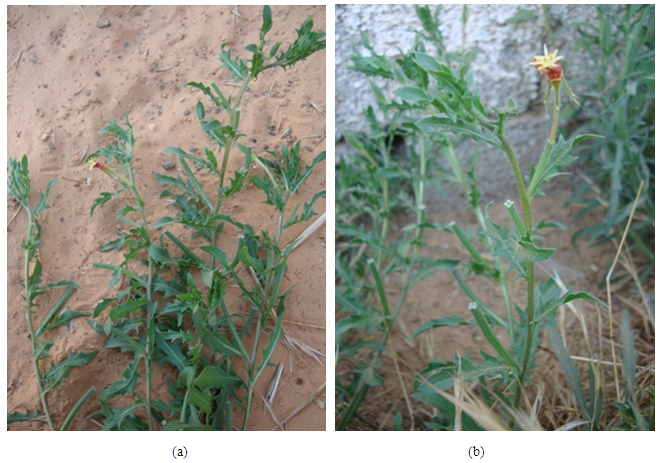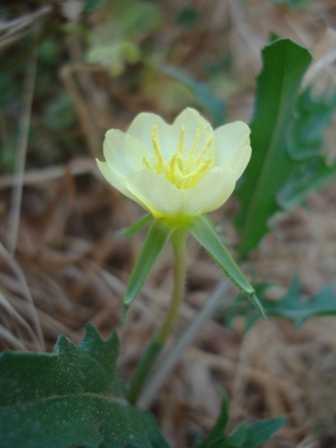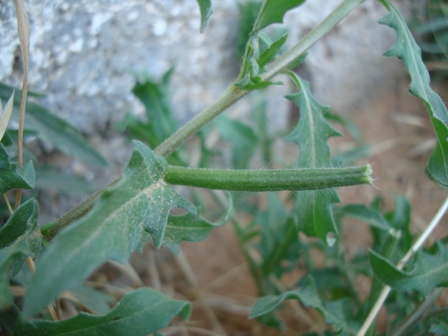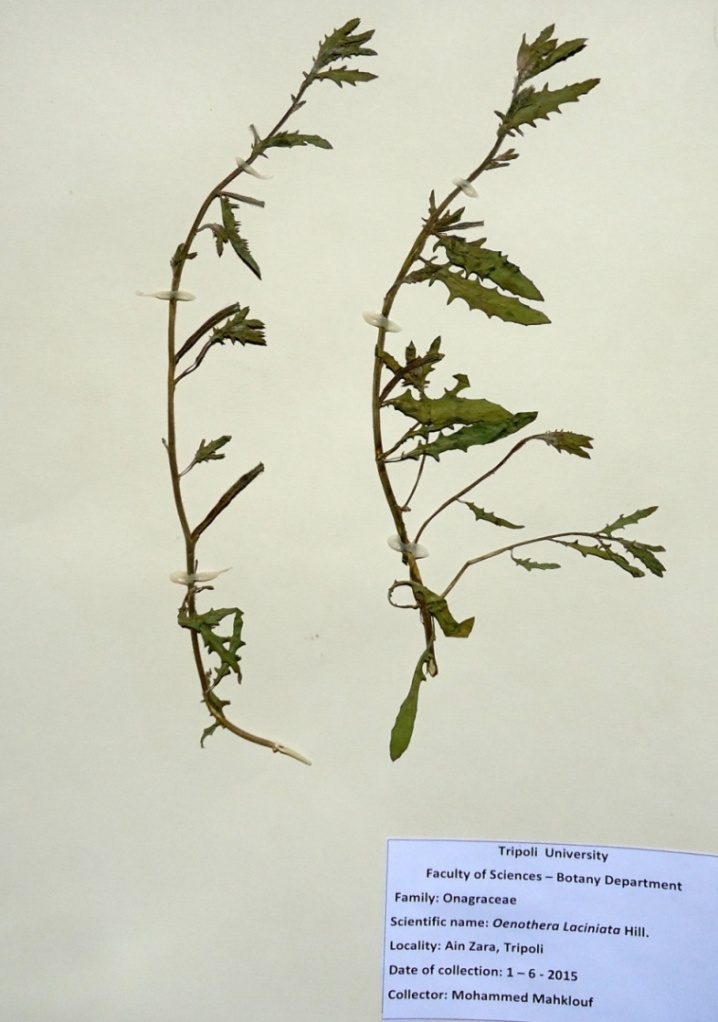-
Paper Information
- Previous Paper
- Paper Submission
-
Journal Information
- About This Journal
- Editorial Board
- Current Issue
- Archive
- Author Guidelines
- Contact Us
International Journal of Modern Botany
p-ISSN: 2166-5206 e-ISSN: 2166-5214
2016; 6(1): 6-9
doi:10.5923/j.ijmb.20160601.02

A New Record Oenothera laciniata Mill. for the Flora of Libya
Mohammed H. Mahklouf
Department of Botany, Faculty of Science, Tripoli University, Tripoli, Libya
Correspondence to: Mohammed H. Mahklouf, Department of Botany, Faculty of Science, Tripoli University, Tripoli, Libya.
| Email: |  |
Copyright © 2016 Scientific & Academic Publishing. All Rights Reserved.
This work is licensed under the Creative Commons Attribution International License (CC BY).
http://creativecommons.org/licenses/by/4.0/

Oenothera laciniata is reported for the first time for the flora to Libya which is a new generic record as well. The specimens were collected from Ain Zarar region belonging to Tripoli province in the North West part of Libyan coast. This exotic species is native to the eastern part of North America, and it should be considered as a potential invader in the Mediterranean ecosystems. Morphological descriptionis provided to facilitate further identification of this species and to warrant its future detection as well.
Keywords: Onograceae, Oenothera laciniata, Invasive, Weed
Cite this paper: Mohammed H. Mahklouf, A New Record Oenothera laciniata Mill. for the Flora of Libya, International Journal of Modern Botany, Vol. 6 No. 1, 2016, pp. 6-9. doi: 10.5923/j.ijmb.20160601.02.
1. Introduction
- Oenonthera is a large genus belongs to the family Onagraceae with about 120 – 145 species [1, 2], native to North, temperate and subtropical America, now it introduced in many other countries [3], where often colonize altered environments, vegetation open, often in abandoned crops, roadsides and dunes [3, 5, 6, 7]. Species of the genus Oenothera L. often grow in open disturbed habitats in temperate subtropical areas of North, Central, and South America, The greatest number of species can be found in Mexico and the northern part of Central America [8], now it naturalized in South Africa, Astralia and Europe, with the center of diversity in S. W North America [9]. Some species are considered weeds, many of the species are grown in gardens or have commercial interest. The spread of invasive Oenothera spp. throughout Europe over the last 200 years was studied by [10, 11]. Most species of this genus flower only once when long days and short nights occur, the flowers open either near sunset or near sunrise [12]. At present O.laciniata is considered naturalized in much of the world, including south western Europe [13, 14] O.laciniata is largely naturalized and potentially harmful by its invasive nature, it seems appropriate to offer here a detailed description and equipment graphic from the collected area, All this can facilitate detection new populations in the foreseeable case that continue to expand our territory, helping to monitoring.
2. Materials and Methods
- Plant specimens were collected from Ain Zara region about 20 km south east of Tripoli, in the North Wast part of Libyan coast N 32° 49' 33.53'' and E 13° 17' 53.42'' (Fig 5). Monitotoring the plant and gathering of plant specimens were conducted within two consecutive years between 2014 – 2015.Plant specimens were examined carefully, characterized with detailed description and equipment graphic from the collection locality within the two consecutive years o the study , all this can facilitate detection new populations in the foreseeable case that continue to expand our territory, helping to monitoring. The identification of the species was authenticated by Dr. Mohammed Mahklouf, Department of Botany, Faculty of Sciences, Tripoli University, with the aiding of data from the following literature [9, 15].The specimens were deposited at the national herbarium of the Department of Botany, Faculty of Sciences, Tripoli University, Libya.Taxonomic descriptionOenothera laciniata Hill, Veg. Syst. 12, App.: 64. 1767. Synonym: Raimannia laciniata (Hill) Rose ex Britton & A. Brown. Oenothera laciniata var. mexicana, O. mexicana, Raimannia Mexicana English name: Cutleaf evening primroseHerbs erect to procumbent, annual or short-lived perennial, branched from base, usually with basal rosette leaves. Stems 10 - 80 cm long, simple or branched, covered with spreading hairs, often with glandular hairs on inflorescence. Leaves green, with inconspicuous veins, pubescent, rosette leaves petiolate, and cauline leaves sessile to shortly petiolate, blade 4–15 × 1–3 cm; cauline leaves narrowly lanceolate or narrowly elliptic, 2–10 × 0.5–3.5 cm, base narrowly cuneate, margin deeply lobed to dentate, apex acute. Inflorescence a lax open leafy spike, terminal. Flowers open near sunset, one per stem per day; 25 - 30 mm across, rotate, hypanthium foming floral tube 1.5–3.5 cm, upcurved in bud. Sepals 4, free or fused near the base, 5–15 mm, strongly reflexed, narrowly triangular to narrowly lanceolate with a free, acute terminal apices, 12.5–17.5 × 2.5–3.5 mm (including apices), green with reddish midvein, covered with long hairs, the apices narrowly conic and 1.5−3.3 mm long, solid. Petals 4, 5–22 mm, spreading, yellow to pale yellow, fading to orange, cordate, veined, apex broadly bilobed, lobes rounded. Stamens 8, in one row, 7–10 mm, anthers exserted, versatile, dithecal, linear, 4.8–5 mm long, pale yellow, longitudinally dehiscent; Ovary inferior, strigillose, with spreading and sometimes few glandular hairs, narrowly oblong, 11–18 mm long, 4-sided with rounded angles and 4 shallow grooves, 4-loculed, each locule with numerous ovules attached to center; style exserted, cylindrical, 25–35 × 0.5–0.7 mm, pale green to greenish yellow; stigma conspicuously 4-lobed, lobes spreading, 3.5–5.3 mm long, yellowish to greenish yellow. Fruit capsule, cylindrical, sessile, loculicidal dehiscent by 4 valves, many seeded, slightly club-shaped, 3 - 4.5 mm, 4-lobed in transverse section, valves ascending-hirsute and pubescent. Seeds in two rows per locule, brown to dark brown, ellipsoid to suborbicular, 0.9–1.8 mm, slightly reticulate.(Fig 1 a & b, 2, 3).Fl. Apr – Sep. Fr. May – Oct.
 | Figure 1. (a) & (b) Habit |
 | Figure 2. Flower |
 | Figure 3. Fruit |
 | Figure 4. Herbarium specimen |
3. Results and Discussion
- Oenothera laciniata is reported for the first time in the Ain Zara region about 20 km south east of Tripoli, N 32° 49' 33.53'' and E 13° 17' 53.42'' (Fig 5). a report that also constitutes its new generic record Oenothera L. to the Flora of Libya. This exotic species is native to the eastern part of North America, and it should be considered as a potential invader in the Mediterranean ecosystems, it reported for the first time in the Valencian Community (E of Spain) as an invasive species [15, 16].
 | Figure 5. A map of Libya showing site of collection |
 Abstract
Abstract Reference
Reference Full-Text PDF
Full-Text PDF Full-text HTML
Full-text HTML